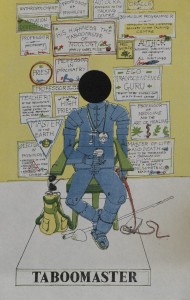This post is part of an ongoing series featuring items from the newly acquired Santo Domingo collection.
Trephination is a surgical intervention in which a hole is drilled or scraped into the human skull, exposing the membrane that surrounds the skull in order to treat health problems related to intracranial diseases. Often referred to as a “burr” hole it relieves pressure beneath the surface. Hieronymus Braunschweig was a German physician and surgeon in the mid 15th-century who authored several treatises on surgery and anatomy including Dis ist das Buch der Cirurgia which has an engraving depiciting trepanation that we see here. Countway has an edition by Brunschwig in their Rare Books collection, Dis ist das Buch der Cirurgia : Hantwirckung der Wund Artzny / von Hiero[n]ymo Bru[n]schwig. Strassburg : Johann (Reinhard) Grüninger, 4 July 1497.
By the 20th-century self-trephination was championed by many as a way to increase “brain blood volume” including a Dutch librarian named Bart Huges. Though Huges attended medical school at the University of Amsterdam he was reportedly refused a degree due to his advocacy of marijuana use. In 1965 Huges drilled a hole in his own head with a Black and Decker power drill  to increase his “cerebral metabolism.” His theory was that when mankind began to walk upright, our brains drained of blood, and that trephining allows the blood to better flow in and out of the brain, causing a permanent “high.” To date there is no scientific proof to back up his theory. He wrote about trephination and other thoughts which have been translated in this edition of The book with the [hole] : autobiography. There is indeed a hole punched throughout the entire volume.
to increase his “cerebral metabolism.” His theory was that when mankind began to walk upright, our brains drained of blood, and that trephining allows the blood to better flow in and out of the brain, causing a permanent “high.” To date there is no scientific proof to back up his theory. He wrote about trephination and other thoughts which have been translated in this edition of The book with the [hole] : autobiography. There is indeed a hole punched throughout the entire volume.
The book with the [hole] : autobiography / by Bart Huges ; translation and elaboration by Joe Mellen and Amanda Feilding. Amsterdam : F.I.T, 1972. RD529 .H89 1972 can be found at the Countway Library at the Harvard Medical School in Longwood.
Thanks to Alison Harris, Santo Domingo Project Manager and Joan Thomas, Rare Book Cataloger at Countway for contributing this post.

